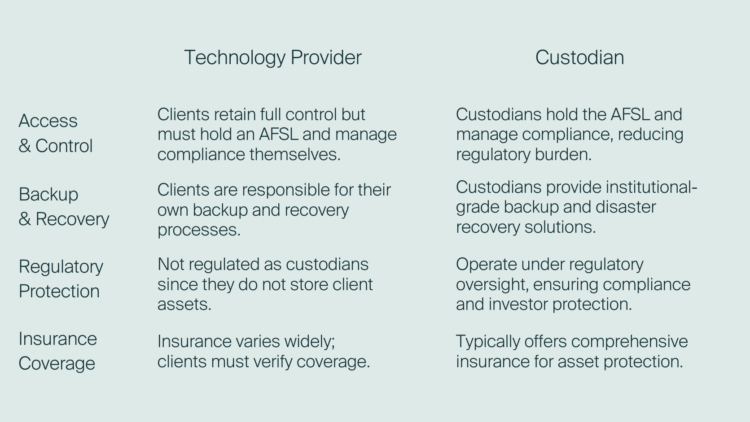Custodians vs. Technology Providers: Why the Right Choice Matters
As institutional adoption in digital assets grows, understanding the difference between custodians and technology providers has never been more important. Investors need to carefully consider control, security, regulatory compliance, and the complexity of managing these assets. Choosing the right partner can significantly impact how safely and efficiently you manage your digital investments.
The key distinction lies in regulatory responsibility: institutions opting for self-custody through a technology provider must hold an Australian Financial Services Licence (AFSL) and implement the associated controls themselves. In contrast, custodians hold the license and manage compliance, significantly reducing the regulatory burden for institutions.
With ASIC’s proposed updates to INFO 225 and the requirement for digital asset platforms to obtain an AFSL, institutions are facing growing compliance obligations. For most, custodianship offers the strongest foundation for security, compliance, and long-term scalability.
Digital Asset Custodians vs. technology providers: A refresher
So, what are custodians and technology providers, and how do they differ?
Custodians
A digital asset custodian is a trusted third party that securely holds digital assets on behalf of their clients. With registrations and licenses from relevant regulatory bodies, custodians provide safekeeping, compliance with jurisdictional regulations and institutional-grade security to keep assets secure.
Often branching out beyond pure custody, many custodians offer value-added services that connect participants into the wider digital asset ecosystem, such as off-exchange settlement, yield-generating opportunities and access to staking.
Technology Providers
Technology providers (specialising in custody) offer the infrastructure and software for institutions to manage the custody of their own assets, providing secure storage and management solutions without holding client assets themselves. However, under this model, institutions must obtain and manage their own AFSL and ensure compliance independently.
The key differences
Now that we’ve outlined what a custodian is vs what a technology provider is, let’s explore the key differences:

Why institutions are moving towards custodians
As regulatory oversight increases and security concerns persist, more institutions are opting to appoint a custodian to look after their assets. By doing so, they benefit from:
- Regulatory alignment – custodians operate within AFSL and INFO 225 frameworks, ensuring compliance without institutions needing to manage internally.
- Institutional-grade security – custodians provide secure storage and recovery options, mitigating the risks associated with lost or compromised assets.
- Reduced operational burden – by choosing a custodian, institutions eliminate the need to build in-house security, compliance, and governance teams, freeing up resources for business growth.
- Risk mitigation & insurance – Unlike technology providers, custodians often offer higher-grade insurance coverage for digital assets.
The future of custody in Australia
With Australia’s digital asset regulatory framework tightening, institutions can no longer afford to take a passive approach to asset security. The risks of self-custody are growing, and the need for regulated, institutional-grade solutions is clearer than ever.
Share article:
Frequently Asked Questions
What is the main difference between a digital asset custodian and a technology provider?
A digital asset custodian securely holds client assets and assumes regulatory responsibility under relevant licences such as an AFSL. A technology provider offers custody infrastructure and software but does not hold assets or regulatory responsibility. Institutions using a technology provider must manage their own licensing, compliance, and operational controls.
Why does regulatory responsibility matter when managing digital assets?
Under ASIC’s proposed updates to INFO 225, digital asset platforms must obtain an AFSL. Institutions using self-custody solutions therefore carry full regulatory and compliance burdens. Custodians already operating within these frameworks can reduce this pressure by managing licensing obligations and associated risk controls on behalf of clients.
What are the main advantages of using a digital asset custodian?
Custodians provide institutional-grade security, regulatory alignment, and reduced operational overhead. They manage safekeeping, compliance, and governance, allowing clients to focus on growth. Many custodians also offer additional ecosystem services such as off-exchange settlement, staking, or yield opportunities – all within a secure and compliant environment.
When might an institution choose a technology provider instead of a custodian?
Institutions that prefer direct control over their private keys or wish to build bespoke internal custody systems may opt for a technology provider. However, this model requires holding an AFSL, implementing full compliance and risk frameworks internally, and maintaining specialised in-house security expertise.
How is Australia’s regulatory landscape influencing custody decisions?
With ASIC strengthening oversight of digital asset platforms and expanding AFSL requirements, institutions face increasing compliance obligations. Many are therefore shifting toward custodians that already operate under these frameworks, minimising regulatory complexity and ensuring long-term scalability and investor protection.
Stay up-to-date
Sign up for the latest news, research and events from Zodia.

Get in touch
Our friendly team is always here to chat







